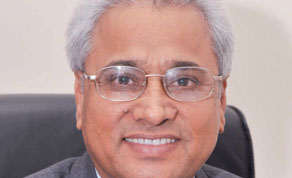 |
| Surya Nath Mishra: Nepal’s ambassdor |
New trade and investment agreements between Qatar and Nepal will allow investors to explore the “abundant potential for promoting bilateral trade, tourism and foreign direct investment,” according to the Nepalese ambassador to Qatar.
Surya Nath Mishra told Gulf Times that the Government of Qatar has sent a draft agreement on investment promotion and protection to Nepal, which is currently under consideration. Mishra believes that this important agreement, as well as an agreement with the Hassad Food Company, will be signed at the next meeting between the two heads of state.
Nepal has already sent an invitation to HH the Emir for an official state visit, and so it is likely to be only a matter of time before these agreements are implemented.
Mishra said that “potential investors in Qatar are eager to make investments in the energy sector, tourism sector, service sector – hotels, banking companies, insurance companies.”
He explained that there are three main sectors that have the potential to contribute significantly to Nepal’s development: agriculture in the abundant fertile flatlands; the world’s second richest water resource system (after Brazil) which, if developed, can generate 85GW of electricity which the country desperately needs; and remarkable natural beauty and a rich cultural heritage that currently draws in 750,000 tourists a year.
Nepal produces organic fruit, vegetables, rice and pulses, tea, coffee, spices, honey, carpets, jewellery, garments, mustard oil, flour and snack foods which would be of interest to the Qatari market. Unfortunately, as a landlocked country, transport costs from Nepal are considerable. Bangladesh and India signed a railway agreement last year, and Bangladesh is going to launch a railway project this year. If Nepal uses port facilities in Bangladesh it will result in shorter transport time than using the port in Calcutta, which is 583km from Nepal’s border.
Tourism has seen a 20% growth two years in a row, as more Asian tourists discover Nepal’s potential for adventure. Year after year, Nepal’s tourism industry beats the WTO’s forecast of 3-5% growth, and the Tourism Board’s target of 1mn visitors in 2012 does not seem so far fetched.
“Unfortunately, maybe we haven’t been able to catch the attention of the Middle East … because Nepal is an adventure destination, it’s challenging, and I think if we can add a bit of softness to that adventure we can probably catch the Middle East market, and we are definitely going towards that direction,” Yogendra Manshakya, a senior official at the Nepal Tourism Board, told this correspondent on a recent trip to the Himalayan Kingdom.
Officials from the Nepal Tourism Board are hoping that new investments in high-end tourism infrastructure will result in the kind of influx of Gulf tourists Thailand has seen in recent years, where many GCC nationals have invested in and built hotels.
Nepal is already well connected to Qatar, with over 300,000 Nepalis working in the country. As Manshakya said: “Many Middle East (airline) carriers are already coming here so they already have established a market here. Once you link airlines, you carry people, you carry investments, so I think the prospects are there.”
Twelve years of insurgency discouraged investments in Nepal, as Maoists fought to overthrow a monarchy that many saw as inept and corrupt. A peace process that has been in place for five years is expected to bring about a new constitution this year, with a democratic government at the head of the young republic.
Government investment in infrastructure and development is currently going towards areas which were previously ignored, focusing on rural villages “where the problems are quite acute,” said Manshakya. “They need water, they need sanitation, so I think when a country doesn’t have enough capital of its own then you have to go to the basic needs. Infrastructure development such as good airports, good roads, gets a second priority, but if we want tourism we will also have to focus on this kind of infrastructure. After twelve years of insurgency, we need to focus on rural areas and this kind of infrastructure is seen as luxury.”
He agrees that there is still a need to develop the type of infrastructure that generates income to assist with funding development for rural areas, and that the Arab world can play a role in this endeavour.
With the Himalayas all around, there is an abundant supply of water systems to generate hydroelectricity, so energy is something that Nepal could produce and even export to its neighbours. “India needs a lot of energy. But that also requires a lot of investments and at the moment I think our challenge is how to attract these investments so that we can turn water into electricity and we can draw more tourists from the region and Middle East. Investment is the catch word today, and that’s why 2012-2013 the Government is also declaring the Nepal Year for Investment,” said Manshakaya.

